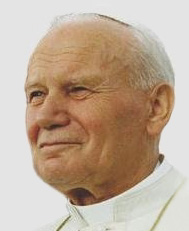Why Are Canonizations Such a Big Deal?
 Two popes on the altar. Two other popes—one reigning, one retired—on hand to fête them. Over a million pilgrims descending on Rome: 1,700 chartered buses in from Poland alone; 58 private planes, 5 trains; and a passenger ship from Barcelona. We’ve heard the term “Catholic Lollapalooza” before but, is there any doubt that the canonization of Popes John XXIII and John Paul II on Sunday April 27 reaches a new level of hoopla?
Two popes on the altar. Two other popes—one reigning, one retired—on hand to fête them. Over a million pilgrims descending on Rome: 1,700 chartered buses in from Poland alone; 58 private planes, 5 trains; and a passenger ship from Barcelona. We’ve heard the term “Catholic Lollapalooza” before but, is there any doubt that the canonization of Popes John XXIII and John Paul II on Sunday April 27 reaches a new level of hoopla?
We moderns can be overly cynical and react to this much excitement with a predictable skepticism. Yet the sheer spectacle of this event points us to an important component of the Catholic tradition of canonizing saints. We mean for these occasions to be a big deal.
The “Martyrium Policarpi,” memorializing the martyrdom of St. Polycarp in 155 A.D. in Smyrna (present day Turkey) describes the attitude of the earliest Christians about how saints should be commemorated. The author describes how the community preserved the saint’s relics to be used in future remembrances. “Gathering here, so far as we can, in joy and gladness,” he writes, “we will be allowed by the lord to celebrate the anniversary day of his martyrdom.”
A thousand years later, Chaucer, in the “Canterbury Tales,” writes about the pilgrimage Christians of his era made to Kent, England, to venerate the shrine of St. Thomas Becket. In Chaucer’s work, a cross-section of 14th century society communes in this pilgrimage, swapping tales in a story-telling contest in exchange for a free dinner at the local Inn. The pilgrims include a knight, a miller, a man of law, a monk, a prioress, a clerk—in short, a miniature version of the gathering in Rome for the papal canonization double-header this year.
The reason that the celebration of the saints has always been a big deal is that it is a central feature of the Catholic Church to continually proclaim sainthood. The First Council of Constantinople in 381 declared the “four marks of the Church” to be that she is “one, holy, catholic and apostolic.” The second of these marks, “holy,” is the one that the canonization process relates to.
The assertion that “holy” people exist today is naturally startling. I remember when I was young hearing a parish elder say, in earnest, that she did not think there were saints among us, anymore. To her, saints had been relegated to a bygone era. Perhaps in Chaucer’s time, when churches were the grandest buildings in any Western town and religion held a central place in peoples’ lives, we could talk about saints, but not in our sinful era!
Pope Francis quietly refuted this view during his General Audience a few days before the canonizations. Faith inspires us to “overcome the temptation to look back, to what was yesterday, and pushes us forward towards the future,” said the Pontiff. “Jesus is not in the sepulcher, he is the Risen One!” He is not relegated to the past, just as He is not confined to the sepulcher, and we need not just look to the past, but all around us, to find Him.
The grand canonization carnival in Rome blares out to the world that those who think that sainthood is dead are wrong, and perhaps we need a megaphone to make this point and have it heard above the din of our noisy modern existence.

